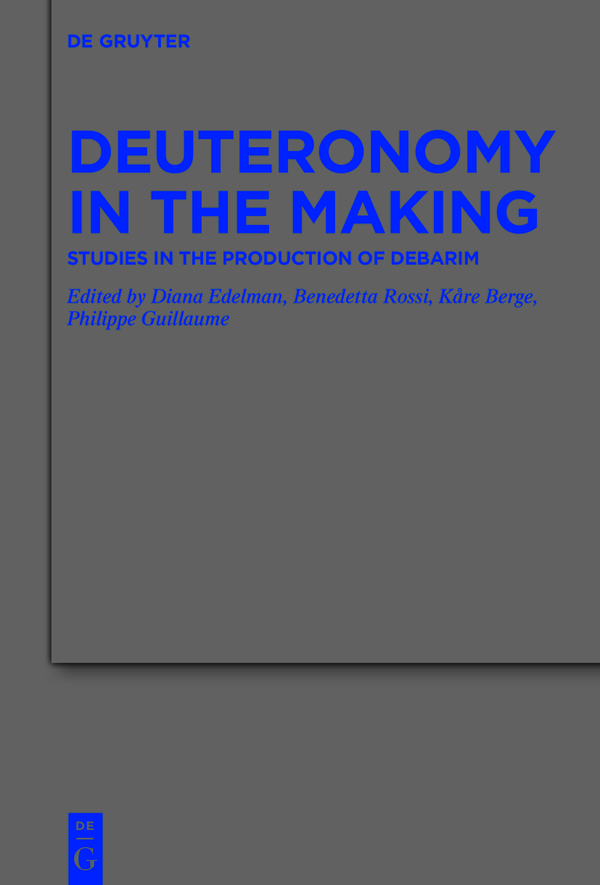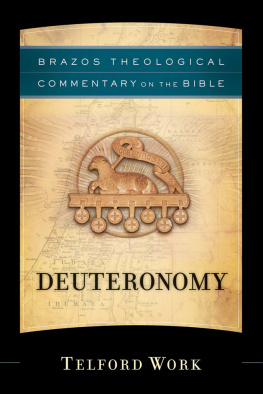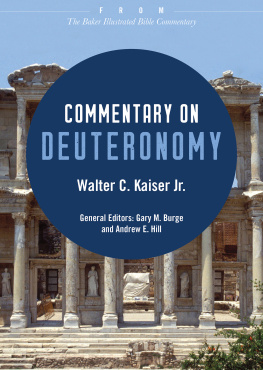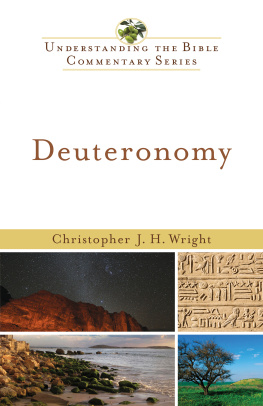Diana Edelman - Deuteronomy in the Making: Studies in the Production of Debarim
Here you can read online Diana Edelman - Deuteronomy in the Making: Studies in the Production of Debarim full text of the book (entire story) in english for free. Download pdf and epub, get meaning, cover and reviews about this ebook. year: 2021, publisher: De Gruyter, genre: Religion. Description of the work, (preface) as well as reviews are available. Best literature library LitArk.com created for fans of good reading and offers a wide selection of genres:
Romance novel
Science fiction
Adventure
Detective
Science
History
Home and family
Prose
Art
Politics
Computer
Non-fiction
Religion
Business
Children
Humor
Choose a favorite category and find really read worthwhile books. Enjoy immersion in the world of imagination, feel the emotions of the characters or learn something new for yourself, make an fascinating discovery.

- Book:Deuteronomy in the Making: Studies in the Production of Debarim
- Author:
- Publisher:De Gruyter
- Genre:
- Year:2021
- Rating:5 / 5
- Favourites:Add to favourites
- Your mark:
- 100
- 1
- 2
- 3
- 4
- 5
Deuteronomy in the Making: Studies in the Production of Debarim: summary, description and annotation
We offer to read an annotation, description, summary or preface (depends on what the author of the book "Deuteronomy in the Making: Studies in the Production of Debarim" wrote himself). If you haven't found the necessary information about the book — write in the comments, we will try to find it.
Diana Edelman: author's other books
Who wrote Deuteronomy in the Making: Studies in the Production of Debarim? Find out the surname, the name of the author of the book and a list of all author's works by series.
Deuteronomy in the Making: Studies in the Production of Debarim — read online for free the complete book (whole text) full work
Below is the text of the book, divided by pages. System saving the place of the last page read, allows you to conveniently read the book "Deuteronomy in the Making: Studies in the Production of Debarim" online for free, without having to search again every time where you left off. Put a bookmark, and you can go to the page where you finished reading at any time.
Font size:
Interval:
Bookmark:

Beihefte zur Zeitschrift fr die alttestamentliche Wissenschaft
Edited by
Volume
ISBN 9783110713053
e-ISBN (PDF) 9783110713312
e-ISBN (EPUB) 9783110713411
Bibliographic information published by the Deutsche Nationalbibliothek
The Deutsche Nationalbibliothek lists this publication in the Deutsche Nationalbibliografie; detailed bibliographic data are available on the Internet at http://dnb.dnb.de.
2021 Walter de Gruyter GmbH, Berlin/Boston
It is common for textbooks to describe the book of Deuteronomy as a law code (chs. 1226) framed secondarily by narratives (chs. 111 and 2734). This understanding has derived from the partial overlap in material in chs. 1226 with what have been identified as legal formulations in Exodus and Leviticus, resulting in the commonly dubbed Deuteronomic Code, (DC) Covenant Code (Exod 20:2223:33) (CC), and Holiness Code (Lev 1726) (HC), respectively. It also is based on the appearance of similar collections elsewhere in the ancient Near East. Scholars have tended to do comparative work between two or among all three biblical collections or between ancient Near Eastern collections and individual regulations in the three biblical collections.
Almost no work has focused specifically on the collection of materials in Deuteronomy 1226, however, to try to understand if they contain an inner logic that might suggest an older purpose and setting as an independent composition prior to being framed to create the first version of the book of Deuteronomy. This was the original focus of the present volume. However, as the list of contributors expanded, along with the list of topics explored, it became logical to widen the focus to accommodate the collection more adequately. The astute reader will easily spot the papers whose main focus is on chs. 1226 or some portion thereof and a possible identification of an Ur-composition and its possible function.
Contributors to the present volume have been asked to define what they consider to have been included in the hypothetical core, and the answers are surprisingly varied. As Megan B. Turton helpfully notes in her essay, however, the very notion of a core is unclear in the larger scholarship on the book of Deuteronomy. Some in the field take it in a temporal sense to designate the earliest form of Deuteronomy, others to designate the casuistic portion of the legal collection (chs. 1925). Yet others use it to designate whatever occupies a key central position within the book. Finally, there are those who would define the core by texts that are historically and theologically central to the message of the book. The varied answers within the present twelve essays reflect the ambiguity within the field at large.
The essays in Part One explore the production of the earliest form of the book in some cases (Philip R. Davies, Baruch Halpern, and myself) and the core in other cases (Bill T. Arnold, Graeme Auld, Kre Berge, and Philippe Guillaume), in different ways. Davies starts with the prominence of the name Israel for the society envisioned in the book and then turns to the history of the northern kingdom of Israel to understand the origin of the core and the book. He proposes the core resulted from a process of reasserting and redefining the identity of Israel, initially under King Jeroboam (I/II) who ruled in the eighth century BCE when new territories and population groups became part of the kingdom and needed to be acculturated. This existing core was expanded and reused for the same purpose after 722 BCE, when Israel ceased to exist and the kingdom and its historical core territory became the Assyrian province of Samerina. New population groups were introduced that needed to learn the customs and practices (collectively, mipa) associated with the local god of Israel.
As a challenge to the existence of an older, independent core that was secondarily framed, my article examines the genres used in the book and various formal structuring devices that have shaped the entire book. When this is done, chs. 1226 or some lesser version of the verses currently contained within those limits do not stand out as likely to have existed in written form for some particular purpose. Themes and patterns cut across the core and the frames. I put forward the very minority view, which I have been told is unlikely to be found persuasive, that the creator of the book was responsible for gathering together the collection of materials in chs. 1226, no doubt drawing on older collections and compositions but also adding new material when it suited his purpose. I propose a date in the early Achaemenid period and leave open the possibility that its intended audience included members of the Samarian as well as Judean literati.
Berge presents a reading of the core as an exercise in resilience penned during Achaemenid imperial control. Such projects are by definition risky, but they call for disruptive change aimed at altering collective self-identity within a situation of contemporary imperial domination in a way obscured from those in power. He traces a number of reuses of royal ideology in the envisioned refiguration of Israelite society in the core, which advocates local autonomy and has as its point of reference the nuclear family. The annual pilgrimage to the moveable mqm is modelled on the royal Achaemenid practice of traveling between royal palaces and providing feasts for dependent workers.
Halpern looks at the contents in his core form of Deuteronomy he dubs D622, defined as chs 528 but possibly chs 133, whether duplicated elsewhere or not. He finds the underlying purposes to be the addition of population to enact further a state-endorsed agrarian entrepreneurship and the creation of an Israelite identity based on public state-funded religious festivals and the concomitant elimination of phratry-based kinship identities reinforced by local lineage celebrations overseen by their kmer-priests. While the latter already had been a policy in Judah after 701 BCE under Hezekiah and Manasseh, under Josiah, whose court likely penned D622, target audiences included Samarians and Edomites as well as Judahites. He considers the chosen place for Yhwhs name to be an original element that was deliberately ambiguous in its phrasing, allowing for both a single place and any authorized place the king would designate. Altars remained in place in urban boroughs, now attended by Levites, who oversaw life-cycle events, lineage celebrations, commemorations, and other occasions for celebration among other duties.
Arnold, on the other hand, first focuses on the unparalleled material in the Deuteronomic Code, seeking to see if it contains an identifiable ideological agenda that might point to the purpose of the legal material. It includes a chosen centralized sanctuary as an integral ideological element and sees the main ideology to be one god, place, one people.
In his two essays, Guillaume also looks at the contents as a whole but uses contradictions and inconsistencies to eliminate chs. 12:114:21; 16; 18:18, and 25:1726:19 as secondary expansions within chs. 1226. In the first essay in Part One, an original core is identified that centered on an annual family feast of unspecified length held at a mobile chosen place that changed annually but was always in a countryside setting to accommodate the numbers in attendance. The annual change of venue was to ensure that those who lived near the announced locale could profit from selling surplus food and animals to those who converted their non-tax tithe to silver. This would balance out the profits and losses over time for individual families that participated. In the second essay in Part Two, this core is associated with a
Font size:
Interval:
Bookmark:
Similar books «Deuteronomy in the Making: Studies in the Production of Debarim»
Look at similar books to Deuteronomy in the Making: Studies in the Production of Debarim. We have selected literature similar in name and meaning in the hope of providing readers with more options to find new, interesting, not yet read works.
Discussion, reviews of the book Deuteronomy in the Making: Studies in the Production of Debarim and just readers' own opinions. Leave your comments, write what you think about the work, its meaning or the main characters. Specify what exactly you liked and what you didn't like, and why you think so.









